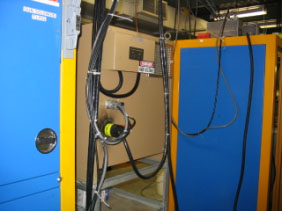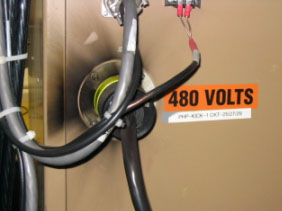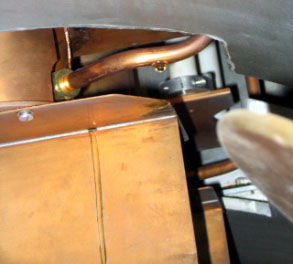|
Friday February 6
The day shift began with Operations monitoring store 3219, with the Antiproton Source (Pbar) stacking, and with MiniBooNE taking beam.
At 9:45 AM, Switchyard and Main Injector (MI) experts began a study period.
A Pbar expert halted stacking at 12:20 PM for a reverse proton study in the Debuncher.
Operations stopped Booster beam at 3:38 PM so technicians could replace a power supply. Beam resumed at 4:01 PM.
Switchyard studies ended at 5 PM.
Pbar studies ended at 5:43 PM, but operations had a problem trying to resume stacking.
MI studies ended at 6:31 PM.
At 7:26 PM, operators noticed that the Tevatron (TeV) sector A0 kicker room had lost power. Operations found a kicker magnet power supply tripped off and the Tevatron Electron Lens (TEL) had also tripped. Operators called in experts to investigate the kickers and the TEL.
At 8:57 PM, operators took the following pictures. They show how the TEL solenoid power supply had failed in a dramatic fashion. This, in turn, took out the A0 kicker room power breaker. More people came in to help resolve this problem.
 
Experts turned the kickers on and had the TEL back in service by 10:44 PM.
Operation terminated store 3219 at 11:01 PM.
Saturday February 7
The midnight shift began with the TeV in a dry squeeze and with MiniBooNE taking beam.
Operations put the TeV into shot setup at 12:46 AM.
At 2:24 AM, Operations established store 3222 with an initial luminosity of 57.14E30.
Operations tuned Booster beam at 3:10 AM to resolve some problems.
At 3:26 AM, a Linac RF station (KRF6) began having a phase problem. Two minutes later it tripped off. Operators then discovered that some workers had opened a roll up door to load equipment into their truck, which had lowered building temperatures. Linac beam returned at 3:50 AM.
Two I- Source vacuum pumps tripped off at 5:03 AM. Operators had the pumps back on and resumed sending beam within a few minutes.
At 6:10 AM, a Pbar septum (A:ISEP1V) began tripping off regularly. By 6:50 AM, A:ISEP2V began experiencing the same problems. Operators called in an expert to help investigate.
A Booster RF station (BRF15) tripped off at 8:08 AM. At 8:11 AM, a Booster power supply (WAPS) tripped and apparently caused all the RF station power supplies to trip. Operators could not get WAPS to reset.
Experts discovered that BRF15 was the root problem and bypassed the station. They had WAPS on by 8:30 AM.
BRF16 tripped off at 8:38 AM.
Operators prepared the Pbar tunnels for access at 9:04 AM. Techs found faulty connectors on the two troublesome septa.
Switchyard experts began a study period at 10:14 AM.
During the process of interlocking Pbar, operators discovered a LCW leak on a RF cavity (ARF1). At 11 AM, an expert said the leak must get repaired.

Experts completed their repairs on ARF1 at 1:11 PM.
After a lot of work, Pbar resumed stacking at 3:30 PM, but unfortunately stacking was halted fairly quickly due to interlock equipment problems. Safety system techs came in and investigated.
Pbar resumed stacking and Switchyard experts resumed studies at 7:25 PM.
At 8:30 PM, Booster RF techs reported that they were still working on stations 11 and 15.
Switchyard experts completed their studies at 9:46 PM.
Booster RF techs reported at 11:56 PM that BRF15 has a problem in the tunnel and BRF11 need a new modulator. Operations configured Booster to operate with 16 RF stations.
Sunday February 8
The midnight shift began with Operations monitoring store 3222, with Pbar stacking, and with MiniBooNE taking beam.
At 3:47 AM, BRF5 tripped off due to an overcurrent indication. It reset okay.
BRF5 began sparking at 6:43 AM.
BRF18 tripped off at 6:51 AM. It reset okay.
Switchyard experts began a study period at 9:24 AM.
KRF5 tripped off at 11:32 AM and then again a couple of minutes later. It reset okay.
Booster techs finished their repairs on BRF11. They tied it back into the RF system at 12:49 PM.
At 12:53 PM, BRF13 tripped the first of five times in thirty-five minutes.
Operations reported at 2:11 PM that the modulator replacement for BRF11 didn't solve the station's problem. A tunnel access is needed.
At 2:37 AM, I- Source vacuum pumps tripped off. They reset okay.
At 5:53 PM, a number of Pbar vacuum pumps tripped off. They also reset okay.
At 6 PM, Pbar suffered a vacuum burst, but operators contained it before it tripped off all the vacuum pumps. Operators had all the vacuum valves back open by 6:45 PM.
Operations terminated store 3222 at 6:41 PM.
Operations prepared the Collider Detector at Fermilab (CDF) and D-zero (D0) for a collision hall access at 6:55 PM. Both experiments were out of access by 8:01 PM.
Operation put the TeV into a dry squeeze at 8:32 PM and then into shot setup at 8:58 PM.
At 10:54 PM, Operations established store 3224 with an initial luminosity of 51.39E30. Pbar resumed stacking.
Monday February 9
The midnight shift began with operators investigating a Linac RF station (LRF3) that had tripped off shortly before midnight, with Operations monitoring store 3224, with Pbar stacking, and with MiniBooNE taking beam.
At 12:06 AM, operators changed out a waveform module for LRF3.
LRF3 tripped off at 12:55 AM. It then tripped off three more times in fifteen minutes. It tripped again at 4:18 AM and then at 7 AM tripped for the first of five times in thirty minutes. It tripped one more time at 7:37 AM.
A Pbar expert began a reverse proton study period at 7:42 AM.
Today's Plans
The plan for today is to allow Booster techs an access to repair their RF system.
Accelerator Update Archive
More Information
For Tevatron luminosity charts and the current status of Fermilab's
accelerators and detectors (live!), please go to Fermilab Now
Comments and Suggestions
What do you think about the Accelerator Updates? Please send comments and suggestions to: accelupdates@fnal.gov.
|